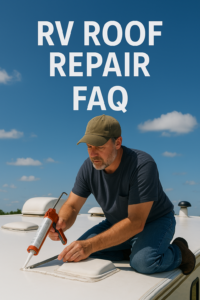RV Roof Repair FAQ: Answers to Your Most Common Questions

Maintaining your RV roof is essential for preventing leaks, water damage, and costly repairs. Here, we’ve compiled answers to some of the most frequently asked questions about RV roof repair and maintenance to help you keep your vehicle in top shape.
1. How Often Should I Inspect My RV Roof?
It’s recommended to inspect your RV roof at least twice a year, ideally in the spring and fall. Additionally, check it after any severe weather conditions or if you notice signs of leaks inside your RV.
2. What Are the Most Common Causes of RV Roof Leaks?
RV roof leaks are often caused by:
- Cracked or damaged sealants around vents, skylights, and seams.
- Punctures or tears from tree branches or sharp objects.
- Wear and tear from sun exposure, causing the roof material to dry out and crack.
- Improperly installed accessories that create gaps in the roof.
3. How Can I Prevent Roof Leaks?
To prevent leaks, follow these maintenance tips:
- Regularly inspect and reseal any cracks or gaps in the sealant.
- Clean your roof every few months to remove debris and dirt buildup.
- Use an RV roof protectant to prevent UV damage and extend the lifespan of the roof material.
- Avoid parking under low-hanging branches that could puncture the roof. Step-by-step process on how to inspect and reseal your RV roof
4. What Are the Different Types of RV Roofs?
The three most common types of RV roofs are:
- EPDM (Rubber Roof): Durable, affordable, but prone to oxidation.
- TPO (Rubber Roof): More resistant to UV damage but can crack over time.
- Fiberglass: Tough and long-lasting but heavier than rubber roofs.
5. What’s the Best Sealant for an RV Roof?
The best sealant depends on your roof type:
- Self-leveling lap sealant (like Dicor) for rubber roofs.
- Silicone or polyurethane sealant for fiberglass roofs.
- EternaBond tape for quick and effective patch repairs.
6. Can I Walk on My RV Roof?
Yes, but with caution. Some RV roofs have built-in support for walking, while others require using a walk board to distribute weight. Check your owner’s manual to confirm if your RV roof is walkable.
7. How Do I Patch a Tear in My RV Roof?
To patch a tear in your RV roof:
- Clean the area thoroughly.
- Apply a patch using RV roof tape (like EternaBond).
- Seal the edges with an appropriate roof sealant.
- Let it cure before exposing it to rain or washing.
8. How Long Does an RV Roof Last?
- EPDM/TPO rubber roofs: 10-20 years with proper maintenance.
- Fiberglass roofs: 20+ years if well cared for.
- Aluminum roofs: Can last indefinitely but require regular sealing.
9. Can I Coat My RV Roof to Extend Its Life?
Yes! Applying an RV roof coating can extend the lifespan of your roof. Look for elastomeric coatings or liquid rubber coatings designed specifically for RVs.
10. When Should I Replace My RV Roof?
Consider replacing your RV roof if:
- It has extensive water damage that cannot be patched.
- Multiple leaks continue to appear even after repairs.
- The roofing material is deteriorating and won’t hold a seal.
Regular inspection and maintenance can help you avoid costly RV roof repairs. Keep an eye on sealants, clean your roof regularly, and address any minor issues before they become major problems. If you’re unsure about a repair, consider consulting an RV repair specialist to ensure your roof stays in excellent condition.
For more RV maintenance tips and product recommendations, explore our other articles on RVRoofRepair.org
1 thought on “RV Roof Repair FAQ”
Comments are closed.